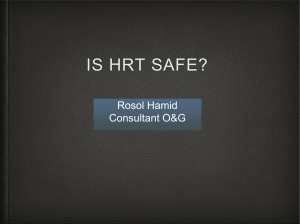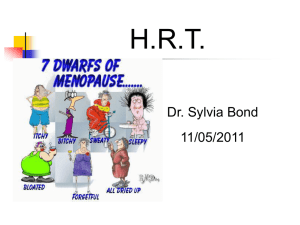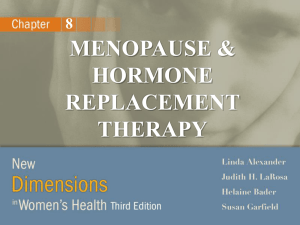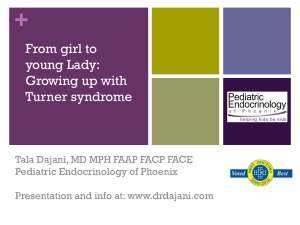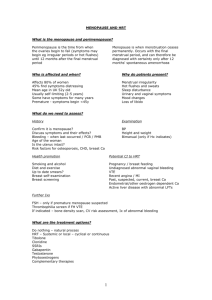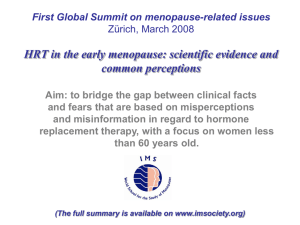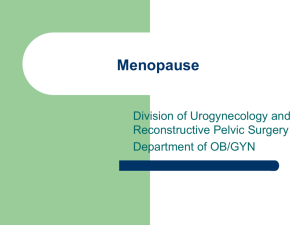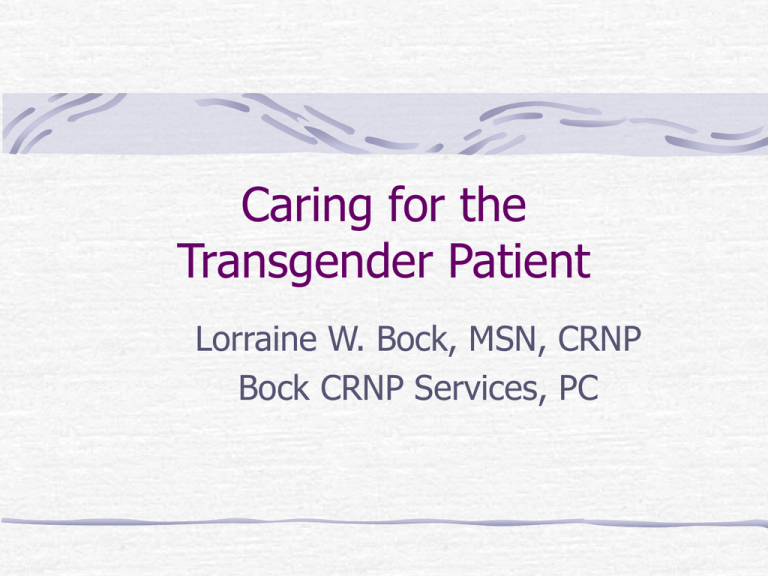
Caring for the
Transgender Patient
Lorraine W. Bock, MSN, CRNP
Bock CRNP Services, PC
Objectives
At the completion of the program attendees will:
Have an understanding of the history of the
transgender movement
Articulate the criteria for diagnosis of Gender Identity
Disorder
Be able to define common terms associated with the
transgender movement
Know the common procedures associated with gender
change
Know the hormones used in Gender Identity Disorder
The Beginning
Dr. Harry Benjamin (1885-1986) – German
born physician trained in Germany with a
special interest in research.
In 1941 was asked to see a child who
“assured to be a girl” whose parent wished to
support the child’s beliefs.
Introduced the term transsexualism in 1954.
In 1966 wrote the book The Transsexual
Phenomenon, the first book on the subject.
Dr. Harry Benjamin
In 1979 the
Harry Benjamin International Gender
Dysphoria Association
was formed and named in honor of
Dr. Benjamin
The protocols in place currently for
hormone replacement are based on his
research.
Definitions
Transsexualism/Transgendered - Person who aspires to or
actually lives in the anatomically contrary gender role. The
transexual identity has been present for at least 2 years. This is
not a symptom of another mental disorder or chromosomal
abnormality.
Dual Role Transvestite/Cross Dresser – An individual that wears
the clothes of the opposite sex in order to experience temporary
membership in that sex. There is no sexual motivation for the
dressing. There is no desire to permanently change to the
opposite sex.
Definitions (con’t)
Gender Identity Disorder (GID) of Childhood
Different Criteria for Boys/Girls
Girls
A. Persistent & Intense distress about being a girl
and has expressed desire to be a boy or insists
that she is a boy
Definitions (con’t)
B. Persistent repudiation of female anatomical
structures as evidenced by one of the following
1. an assertion that she has or will grow a
penis
2. rejection of urination in a sitting
position
3. assertion that she does not want to
grow breasts or menstruate
C. Has not yet reached puberty
D. Symptoms present for at least 6 months
Definitions (con’t)
Gender Identity Disorder (GID) of Childhood
Different Criteria for Boys/Girls
Boys
A. Persistent & Intense distress about being a
boy and has expressed desire to be a girl or
insists that he is a girl
Definitions (con’t)
B. Either of the following must be present
1.) Pre-occupation with stereotypic female
activities as evidenced by cross-dressing or
simulating female attire, or by intense desire to
participate in games and past-times of girls and
rejection of stereotypical male toys, games, &
activities
Definitions (con’t)
2.) Persistent repudiation of male anatomical structures
as evidenced by one of the following
1. an assertion that he will grow up to be
a female
2. that his penis or testis are disgusting or
will disappear
3. that it would be better not to have a
penis or testes
C. Has not yet reached puberty
D. Symptoms present for at least 6 months
Definitions (con’t)
Gender Identity Disorder NOS – One with
a strong persistent identification with
the cross-gender identity. A persistent
discomfort with his or her sex. Sense of
inappropriateness in the gender role
he/she is currently in. Symptoms
present for at least 2 years.
Definitions (con’t)
GG – Genetic Girl
TG – Transgendered Girl
MTF – Male to Female
FTM – Female to Male
GRS – Gender Reassignment Surgery
HRT – Hormone Replacement Surgery
Spiro – Spironolactone
Tim/Trina
The Real Life Experience
Undertake some Combination of:
Maintain FT or PT Employment
Function as a Student
Function as a Community Based Volunteer
Acquire a new legal first or last name
Provide documentation that persons
other than the therapist know that pt
functions in the new gender role.
Hair Removal or Growth
Electrolysis or Laser Hair Removal
Can take up to 2 years of treatments
Painful & Expensive
Rogaine on the Face/Chest
Can have adverse systemic effects
Must be maintained to be effective
Breast Surgery
Augmentation for Men
Most wait until after starting hormones to
see what growth HRT stimulates
Reduction for Females
Most wear binders for several years before
surgery
Difficult to find Plastic Surgeons who will
“go small enough”
Hormone Replacement Surgery
Eligibility Criteria –
18 years of age
Demonstrate knowledge of what hormones
can & cannot do medically and what the
risks are involved with HRT – medical &
social
Either 3 months of documented life
experience OR
Minimum of 3 months of psychotherapy
after the initial evaluation has been
completed
HRT (con’t)
Readiness Criteria
Pt has had further consolidation of gender
identity during the real life experience
Pt has made some progress in mastering
other problems leading to or improving
stable mental health
Hormones are likely to be taken in a
responsible manner
Biologic Effects of HRT
Men
Breast Growth
Redistribution of body fat
Decreased upper body strength
Softening of skin
Decrease in body hair/Stop loss of scalp hair
Decreased fertility and testicular size
Less frequent & less firm erections
Biologic Effects of HRT (con’t)
Females
Permanent deepening of the voice
Permanent clitoral enlargement
Mild breast atrophy/decreased hip fat
Increased upper body strength
Increased facial & body hair growth
Male-pattern baldness
Increased sexual arousability/interest
Medical Side Effects of HRT
Men
Increased risk of DVT/PE
Development of benign pituitary
prolactinemias
Infertility
Weight Gain
Liver Disease
Emotional Lability
Medical Side Effects of HRT
Women
Infertility
Acne
Shift in Lipid Profile
Hepatic Dysfunction/Liver Tumor
Development
Emotional Lability
Increase in Sexual Desire
Relative Contraindications
Known Cardiovascular Disease
Strong Risk Factors for CVD
Cigarette Smoking
Obesity
Clotting Disorders
Some Endocrine Abnormalities
Pre-Treatment Evaluation
Must have the GID letter from psych
Physical Examination w/ BP check
Up to date on age appropriate
screening tests
Estrogen Therapy
CMP, CBC, Free Testosterone Level
Androgen Therapy
Liver Profile, CBC,
On-going Evaluations
Repeat Baseline Labs & Physical Exam
w/ BP check at 6 & 12 months for both
sexes then yearly thereafter
Continue gender specific screening tests
for pre-treatment gender
For those receiving estrogen a prolactin
level is needed at 1, 2,& 3 years
New Screening Tests Needed
Males on Estrogen – Need instructed in
self breast exam & need mammograms
Females on Testosterone – Need annual
liver palpation
Considerations after
Gonadectomy
Estrogen can be reduced by 1/3 to 1/2
after removal of the testes and still
maintain feminization
Testosterone can be reduced by 1/2
after oopherectomy due to risk of
osteoporosis
HRT Dosing
MTF
Oral Estradiol (Estrace®)– 6-8mg PO or SL
Oral Conjugated Estrogens (Premarin®) –
5mg PO
Transdermal Estrogen (Vivelle®) – 2
0.1mg patches changed 2x/week.
AND
Spironolactone 200-400mg/d
HRT Dosing
FTM
Testosterone Injectable – 150-200mg
q2weeks
Transdermal Testosterone (Androderm) – 5
– 7.5mg changed QD
Testosterone Gel (Androgel) – 5-10mg
applied daily
Gender Reassignment Surgery
Mastectomy or Breast Augmentation
Reduction Thyroid Condroplasty
Rhinoplasty
Liposuction of Waist
Face Lift/Facial Bone Reduction
Blepharoplasty
Hysterosalpingo-oopherectomy
Gender Reassignment Surgery
Vaginoplasty by one of 3 methods
Penile Skin Inversion
Pedicles Rectosigmoid Transplant
Free Skin Graft to Neovagina
Phalloplasty including
Vaginectomy
Scrotoplasty
Urethroplasty
Conclusion
Patients who have GID and undergo
treatment whether it is mental health
therapy, HRT or surgical interventions
go through rigorous events in order to
“change.” They have a right to
unbiased, holistic, primary care and
PCP’s must be familiar with the
subtleties of this condition.


